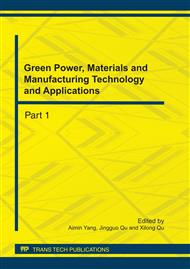[1]
Champaign-Urbana community wireless network. http: /www. cuwireless. net.
Google Scholar
[2]
MIT roofnet. http: /www. pdos. lcs. mit. edu/roofnet.
Google Scholar
[3]
MSR self-organizing neighborhood wireless mesh networks:. http: /www. research. microsoft. com/mesh.
Google Scholar
[4]
Camp, J.D., Knightly, E.W., Reed W.S.: Developing and deploying multihop wireless networks for low-income communities. In Poster of IEEE INFOCOM (2005).
DOI: 10.1080/10630730601146094
Google Scholar
[5]
Raniwala, A., Chiueh, T. cker.: Architecture and algorithms for an IEEE 802. 11-based multi-channel wireless mesh network. In Proceedings of IEEE INFOCOM (2005).
DOI: 10.1109/infcom.2005.1498497
Google Scholar
[6]
Akyildiz, I.F., Wang, X.: Wireless mesh networks: a survey. Elsevier Computer Networks Journal, vol. 47, p.445–487, (2005).
DOI: 10.1016/j.comnet.2004.12.001
Google Scholar
[7]
Fu Z., Luo H., Zerfos, P., Lu S., Zhang L., Gerla, M.: The impact of multihop wireless channel on TCP performance. IEEE Transactions on Mobile Computing, 4(2): 209–221, March/April (2005).
DOI: 10.1109/tmc.2005.30
Google Scholar
[8]
Garetto, M., Shi J., Knightly, E.W.: Modeling media access in embedded two-flow topologies of multihop wireless networks. In Proceedings of ACM MobiCom (2005).
DOI: 10.1145/1080829.1080851
Google Scholar
[9]
Berger, D., Ye Z., Sinha, P., Krishnamurthy, S.: Tripathi. TCP-friendly medium access control for ad-hoc wireless networks: Alleviating self-contention. In Proceedings of IEEE MASS, (2004).
DOI: 10.1109/mahss.2004.1392160
Google Scholar
[10]
Sanzgiri,K., Chakeres I.D., Belding-Royer, E.M.: Determining intra-flow contention along multihop paths in wireless networks. In Proceedings of Broadnets Wireless Networking Symposium (2004).
DOI: 10.1109/broadnets.2004.32
Google Scholar
[11]
C. cheng Chen, H. Luo: The case for heterogeneous wireless MACs. In Proceedings of HotNets (2005).
Google Scholar
[12]
Chen C. cheng, Seo, E.: Self-learning collision avoidance for wireless networks. In Proceedings of IEEE INFOCOM, (2006).
Google Scholar
[13]
Liu J., Singh, S.: ATC: TCP for mobile ad hoc networks. IEEE Journal on Selected Areas in Communications, vol. 19, p.1300–1315 (2001).
DOI: 10.1109/49.932698
Google Scholar
[14]
Sundaresan, K.: ATP: a reliable transport protocol for ad-hoc networks. In Proceedings of ACM MobiHoc (2003).
Google Scholar
[15]
Berger, D., Ye Z., Sinha, P., Krishnamurthy, S.: TCP-friendly medium access control for ad-hoc wireless networks: Alleviating self-contention. In Proceedings of IEEE MASS, (2004).
DOI: 10.1109/mahss.2004.1392160
Google Scholar
[16]
Fu Z., Luo, H., Zerfos, P., Lu, S., Zhang L., Gerla, M.: The impact of multihop wireless channel on TCP performance. IEEE Transactions on Mobile Computing, vol. 4, p.209–221, (2005).
DOI: 10.1109/tmc.2005.30
Google Scholar
[17]
Tschudin, C., Osipov, E.: Estimating the ad hoc horizon for TCP over IEEE 802. 11 networks. In Proceedings of Med-Hoc-Net (2004).
Google Scholar
[18]
Xu S., Saadawi, T.: Does the IEEE 802. 11 MAC protocol work well in multihop wireless ad hoc networks. IEEE Communication Magazine, vol. 39, p.130–137, (2001).
DOI: 10.1109/35.925681
Google Scholar
[19]
Kawadia, V., Kumar, P.: A cautionary perspective on cross layer design. IEEE Wireless Communication Magazine, p.3–11, February (2003).
Google Scholar
[20]
Seiler, P., Sengupta, R.: Analysis of Communication Losses in Vehicle Control Problems, Proc. IEEE American Control Conference, pp.1491-1496, June (2001).
Google Scholar


